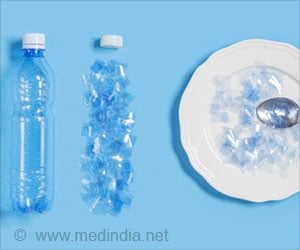- Microplastics have been detected in human brain tissues, with levels increasing by 50% since 2016
- The impact of these particles on brain health is still unclear, but concerns are growing about their potential toxic effects
- Limiting plastic exposure, especially in food packaging, can help reduce the intake of harmful microplastics
In recent years, the presence of microplastics in our environment has garnered significant attention due to their potential health impacts. A growing body of research has revealed that these tiny plastic particles, smaller than a grain of sand, are increasingly making their way into the human body through ingestion and inhalation. Alarmingly, a preprint published in May 2024 uncovered that microplastics are now infiltrating our brains in greater quantities than ever before (1✔ ✔Trusted Source
Bioaccumulation of Microplastics in Decedent Human Brains Assessed by Pyrolysis Gas Chromatography-Mass Spectrometry
). This discovery has raised serious concerns about the potential risks these particles pose to human health, especially given the critical role the brain plays in regulating our bodily functions.
Advertisement
Microplastics in Human Brains
According to the study, brain tissue samples collected in 2024 showed 50% higher concentrations of microplastic fragments than samples collected just eight years earlier. This research, led by Matthew Campen, a professor of pharmaceutical sciences at the University of New Mexico, revealed that the average brain sample contained 4,800 micrograms of plastic per gram of tissue, amounting to 0.5% by weight. This significant increase in plastic contamination highlights the growing threat microplastics pose to human health.
While it is concerning that microplastics are making their way into the brain, it is important to note that the study’s findings do not definitively prove that these particles are causing harm. As Phoebe Stapleton, an associate professor of pharmacology and toxicology at Rutgers University, pointed out, the presence of plastic in the brain does not necessarily indicate that it is causing damage. However, further research is needed to determine whether these particles accumulate in the brain over time and whether they contribute to neurological diseases or impair cognitive function.
Advertisement
How Do Microplastics Enter the Brain?
Microplastics are typically defined as plastic particles smaller than 5 millimeters, while nanoplastics are even smaller, measuring in nanometers. These microscopic shards can come from a wide variety of sources, including plastic packaging, water bottles, and synthetic clothing. Once released into the environment, microplastics can be ingested through food and water or inhaled through the air. They have been found in nearly every part of the human body, including the lungs, liver, kidneys, and even the placenta.
So how do these particles manage to infiltrate the brain? According to Campen, nanoplastics are the most dangerous because their small size allows them to cross the blood-brain barrier, a protective shield that typically prevents harmful substances from entering the brain. Researchers believe that these tiny particles “hijack” their way into the brain by attaching themselves to lipids, or fats, which are essential to the brain’s function. The human brain is made up of approximately 60% fat, making it particularly vulnerable to these intruding particles.
Advertisement
Microplastics and Their Impact on the Brain
Although the presence of microplastics in the brain has been confirmed, the full extent of their impact remains unknown. The researchers found that the brain tissue samples contained 7 to 30 times more microplastic fragments than other organs such as the kidneys and liver. This suggests that the brain may be particularly susceptible to plastic infiltration.
One major concern is that nanoplastics can enter individual cells and potentially disrupt biological processes. These particles can carry with them harmful chemicals, such as bisphenols, phthalates, and heavy metals, which are known to interfere with the endocrine system.
Endocrine disruptors have been linked to reproductive issues, decreased sperm counts, and even certain cancers. The potential for nanoplastics to carry these dangerous substances directly into the brain raises serious concerns about their long-term health effects.
Moreover, scientists worry that these particles could contribute to neurological diseases such as Alzheimer’s and dementia. Studies have shown that the brain is particularly vulnerable to oxidative stress, which can damage cells and contribute to cognitive decline. If microplastics are able to infiltrate the brain and disrupt its delicate balance, they may accelerate the onset of these diseases.
Ways to Reduce Microplastic Exposure
Despite the alarming findings of the study, experts caution against panic. Dr. Philip Landrigan, director of the Program for Global Public Health at Boston College, stresses that while the science surrounding microplastics is still evolving, it is important to take practical steps to reduce exposure. “You’re not going to live without plastic,” he acknowledges, but there are ways to minimize the risks.
One of the most effective ways to reduce microplastic exposure is by limiting the use of single-use plastics, such as plastic bags and water bottles. Opting for alternatives like glass or stainless steel containers can help reduce the amount of plastic that enters our bodies. Additionally, removing food from plastic packaging before cooking or microwaving it can prevent the release of microplastics into the food.
Reducing plastic waste not only benefits individual health but also helps protect the environment. Plastic pollution is a global issue, with millions of tons of plastic waste entering oceans and waterways each year. This pollution breaks down into microplastics, which are ingested by marine life and eventually make their way up the food chain to humans. By reducing our reliance on plastics, we can help mitigate the spread of microplastics in the environment and protect future generations from their harmful effects.
Urgent Need to Reduce Plastic Pollution
The discovery of microplastics in human brains is a stark reminder of the pervasive nature of plastic pollution. While the full extent of the health risks remains unknown, it is clear that action must be taken to reduce exposure and prevent further contamination. Scientists are calling for more research into the effects of microplastics on the brain and other organs, as well as the development of new tools to measure plastic toxicity.
According to Landrigan, “We have some pretty good indications that microplastics and nanoplastics cause harm, even though we are a long way from knowing the full extent of that harm.” He suggests that the time has come to take protective action, both at the individual and policy levels. Governments and industries must work together to reduce plastic production, improve waste management, and promote the use of safer alternatives.
As the evidence continues to mount, it is crucial to raise awareness about the dangers of microplastics and encourage individuals to take steps to protect their health. While we may not be able to completely eliminate plastic from our lives, we can reduce our exposure and mitigate its impact on our bodies and the environment.
The increasing presence of microplastics in the brain is a concerning development that underscores the need for more research and action. While the science is still evolving, it is clear that reducing plastic exposure is a critical step in protecting both human health and the environment. By making small changes in our daily lives, such as using fewer single-use plastics and opting for safer alternatives, we can help reduce the spread of microplastics and safeguard our future well-being.
Reference:
- Bioaccumulation of Microplastics in Decedent Human Brains Assessed by Pyrolysis Gas Chromatography-Mass Spectrometry – (https://pubmed.ncbi.nlm.nih.gov/38765967/)
Source-Medindia



